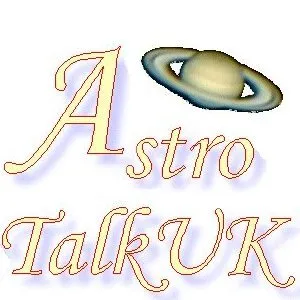
AstrotalkUK
Weekly audio podcast by and predominantly amateur astronomers.
- Update frequency
- every 24 days
- Average duration
- 42 minutes
- Episodes
- 50
- Years Active
- 2013 - 2024

Episode 112 – Brown Dwarfs, Dark Matter and Dark Energy
Euclid, a @esa science mission, will shed light on both dark matter and dark energy. It was launched in July 2023 and arrived in its L2 orbit a month later. It has just two instruments which will pro…
00:48:53 |
Fri 15 Mar 2024

Episode 111 – Chandrayaan-3
Following the successful landing of @isro #Chandrayaan-3, Associate Project Director Kalpana Kalahasti was the first female to speak at the ISRO live stream event. As a seasoned engineer, Kalahasti c…
00:35:07 |
Thu 30 Nov 2023

Episode 110 – Humanity’s spiritual destiny and the 100 year starship
The 100 year starship project @100YSS aims to get humanity to develop the capability to travel to the stars in one hundred years time. It started in 2012 headed by Dr Mae Jemison the first woman of …
00:34:08 |
Fri 10 Nov 2023

Episode 109 – The Antikythera Mechanism with Prof Xenophon Moussas
I first came across the Antikythera Mechanism just over a decade ago. It is still the most incredible artefact from history. It is as out of place in our time as William Shakespeare using an Iphone o…
00:45:21 |
Fri 16 Dec 2022

Episode 108 – NASA’s Europa Clipper Mission
The Clarke Exobelt is the name that Dr Hector Socas-Navarro has given to perhaps the largest structure humans have built. A collection of satellites in earth orbit (geosynchronous) 36,000 km radius.…
00:25:49 |
Fri 25 Nov 2022

Episode 107 – SETI’s new tool – Technosignatures
The Clarke Exobelt is the name that Dr Hector Socas-Navarro has given to perhaps the largest structure humans have built. A collection of satellites in earth orbit (geosynchronous) 36,000 km radius.…
00:40:25 |
Fri 18 Nov 2022

Episode 106 – ESA’s new science missions
European Space Agency's Dr Paul McNamara was studying low-frequency gravitational waves just before they were discovered in 2015. Now he is the astronomy and astrophysics coordinator for the European…
00:43:00 |
Fri 11 Nov 2022

Episode 105 – Return to Titan – Dragonfly
Dr Ralph Lorenz speaks about Dragonfly, a return mission to land on Titan. This mission, for which he is the mission architect, is like no other. It is not really a lander or rover but a quadcopter t…
00:44:04 |
Fri 04 Nov 2022

Episode 104 – William Leitch. The forgotten Scottish Rocket Pioneer
When it comes to the pioneers of rocketry, tradition has it that it was Tsiolkovsky, Goddard and Oberth. in this episode, author Rob Godwin talks about William Leitch from Scotland. He was writing ab…
01:09:01 |
Fri 28 Oct 2022

Episode 103 -Observing the Solar System with the JWST
Astronomer Dr Connor Nixon @shamrocketeer speaks about the @nasawebb program to observe solar system objects using the #JWST led by @hbhammel
00:35:21 |
Fri 21 Oct 2022

Episode 102 – Martian Geology with Prof Sanjeev Gupta
In 1972, Harrison Schmitt became the first (and so far only), scientist to walk on the surface of the Moon. Since then many scientists have brought their scientific insights to understanding to the …
00:30:08 |
Fri 14 Oct 2022

Episode 101 UNOOSA – Peaceful Uses of Outer Space
Niklas Hedman, the Acting Director of the @UN Office for the Peaceful Uses of Outer Space (UNOOSA) talks about @UNOOSA ongoing role in facilitating and promoting the peaceful uses of space in Low Ear…
00:30:26 |
Fri 07 Oct 2022

Episode 100 Sandra Benitez Herrera – ESA Education Outreach
Sandra Benitez-Herrera talks about the opportunities for teachers and students made available by the European Space Agency 's CESAR (Cooperation through Education in Science and Astronomy Research) …
00:27:08 |
Sun 18 Sep 2022

Episode 99 Professor Stamatios Krimigis – Exploring the Solar System with Voyager
A chance meeting with James van Allen led Stamatios Krimigis to build instruments for Mariner 3 and 4. Eventually became a Principle Investigator for the charged particle instrument on voyager which…
00:40:42 |
Fri 09 Sep 2022

Episode 98 Astrophotography with Nik Szymanek
Astrophotographer Nik Szymanek shares his unique perspective on how astrophotography has evolved since the 1980s when he first started. We speak about software and robotic telescopes @telescopelivehq…
01:00:11 |
Mon 18 Oct 2021

Episode 97 Bob Heil’s Moon Bounce Experiment with NASA
Following an unexpected meeting with USA's first Astronaut, Alan Shepard in around 1962. In this episode he recounts a Moon-Bounce experiments with @Nasa.
00:53:41 |
Fri 08 Oct 2021

Episode 96 Seti – The search so far with Jill Tarter
Since the beginning of human civilisation, people have looked up at the night sky and wondered – are we alone? Science and technology of the 20th century has made it possible to try to address that q…
00:35:04 |
Fri 01 Oct 2021

Episode 95 European Space Cooperation DeGaulle to ExoMars with Brian Harvey
The latest book from author Brian Harvey @BrianHarveyAut1, this is probably the first English language analysis of the individuals, institutions and early space projects that would eventually lead, …
01:03:07 |
Fri 24 Sep 2021

Episode 94 Seti – Techniques and Technology with Jill Tarter
How has the ¢SETI evolved over the last 6 decades and especially what can modern technology allow today that was not possible then? With Jill Tarter from @SETIInstitute
00:31:04 |
Fri 17 Sep 2021

Episode 93: Exploring the surface of Titan
On 14th January 2005, the Huygens probe landed on Titan. Saturns and the solar systems largest Moon. This was a joint NAS/ESA mission called Cassini-Huygens. Whilst Huygens landed on Titan, Cassini c…
00:59:42 |
Thu 14 Jan 2021
Disclaimer: The podcast and artwork embedded on this page are the property of [email protected]. This content is not affiliated with or endorsed by eachpod.com.